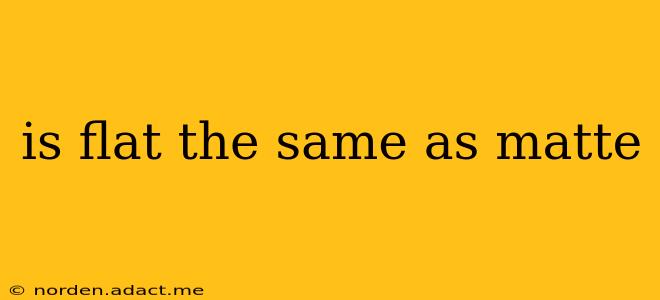The terms "flat" and "matte" are often used interchangeably when discussing paint finishes, leading to confusion. While they share similarities, there are key distinctions that affect the final look and durability of your painted surface. This article will delve into the nuances of each finish, helping you understand their differences and choose the right one for your project.
What is a Flat Paint Finish?
Flat paint, also known as matte paint, boasts a completely non-reflective surface. This means it absorbs light rather than reflecting it, resulting in a very smooth, velvety appearance. The lack of sheen makes it excellent for hiding imperfections in the underlying surface. However, this very characteristic also makes it less durable and more prone to staining and scuffing.
What is a Matte Paint Finish?
Matte paint shares the low-sheen quality of flat paint, but with a slightly more durable composition. While still lacking a significant shine, matte paint possesses a subtle, almost imperceptible sheen compared to the completely flat finish. This slight reflectivity makes it slightly easier to clean and slightly more resistant to wear and tear than a true flat paint. It still hides imperfections well, but its improved durability makes it a more practical choice for high-traffic areas.
What's the Difference Between Flat and Matte Paint? The Key Lies in the Sheen Level
The primary difference lies in the degree of sheen, or gloss. Flat paint has a sheen level of 0-5%, meaning it's virtually non-reflective. Matte paint, on the other hand, typically falls within the 5-10% sheen range. This subtle difference is enough to impact the paint's practicality.
Think of it like this: flat paint is like velvet – incredibly soft and luxurious but delicate. Matte paint is more like a smooth, soft suede – still soft and luxurious but slightly more resistant to wear and tear.
Is Flat Paint Easier to Clean Than Matte Paint?
No, flat paint is significantly harder to clean than matte paint. Its non-porous surface makes it difficult to wipe clean without potentially damaging the finish. Matte paint, with its slightly higher sheen, offers improved washability, though it’s still not ideal for high-scrubbing.
Which Finish is Best for Which Application?
- Flat Paint: Ideal for low-traffic areas where aesthetics are prioritized over durability, such as ceilings, bedrooms, or formal dining rooms. The velvety finish creates a calming and sophisticated ambiance.
- Matte Paint: A better choice for areas that require slightly more durability, such as hallways, living rooms, or children's playrooms. Its enhanced washability makes cleaning spills and smudges easier.
What About Eggshell and Satin Finishes? How Do They Compare?
Both flat and matte finishes are at the lower end of the sheen spectrum. Eggshell and satin paints have significantly higher sheen levels, offering improved durability and washability but sacrificing some of the ability to hide imperfections.
Choosing the right paint finish depends on your priorities and the specific application. Consider the level of traffic, the need for washability, and the desired aesthetic when making your decision. Understanding the subtle yet significant differences between flat and matte finishes will help you achieve the perfect look and long-lasting results for your painting project.
